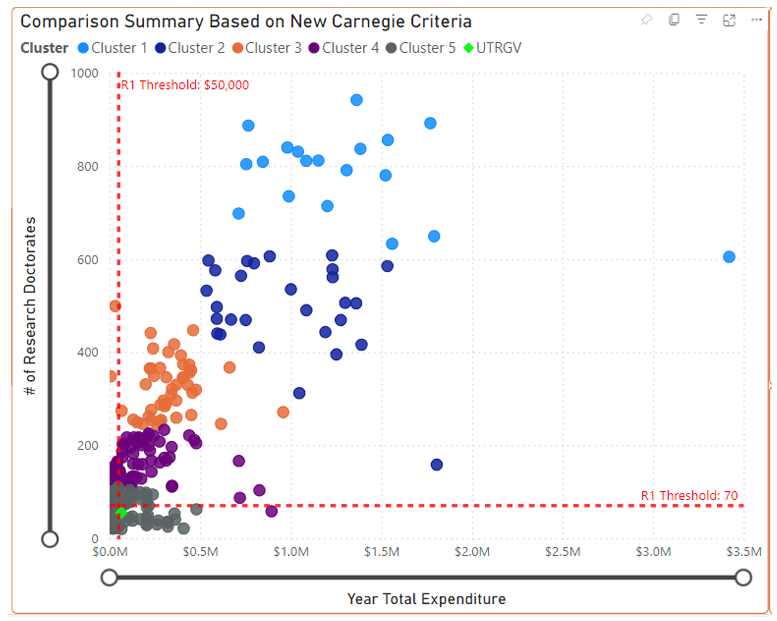Carnegie Classification Comparison Summary

This graph offers a detailed view of how institutions measure up in terms of research investments and doctoral production, key indicators in the Carnegie Classification for doctoral universities. The Carnegie Classification is a widely recognized system that categorizes universities based on their research activity, helping to highlight institutions with significant contributions to research.
Key Variables: Expenditure and Research Doctorates
The scatter plot compares institutions using two main metrics:
- Yearly Total Expenditure (x-axis): This represents the total annual spending on research activities.
- Number of Research Doctorates Awarded (y-axis): This shows the number of doctoral degrees awarded by each institution, emphasizing the scale of its research production.
These metrics are crucial for determining an institution's Carnegie Classification status under the newly updated criteria.
Thresholds for R1 Classification
To qualify as an R1 institution (Very High Research Activity), an institution must meet the following annual thresholds:
- Expenditure Threshold: At least $50 million in research and development spending.
- Doctorate Production Threshold: At least 70 research doctorates awarded.
These thresholds are visually represented on the scatter plot by two red lines:
- The vertical line at $50 million indicates the spending level needed for R1 classification.
- The horizontal line at 70 doctorates represents the minimum doctoral production required for R1 status.
These markers allow users to see at a glance how close each institution is to achieving R1 status.
Cluster Groups and Peer Comparisons
Institutions are color-coded into five clusters based on similarities in research spending and doctoral production, making it easier to identify peer groups:
- Cluster 1 (blue): Typically includes institutions with higher research expenditure and doctorate production.
- Clusters 2 to 5: Each subsequent cluster represents institutions with varying levels of research intensity, with each cluster generally showing lower expenditures and fewer doctorates.
The Cluster legend allows users to quickly see which institutions are performing at similar levels, providing a comparative understanding of where each institution stands in relation to others.
UTRGV in Focus
The University of Texas Rio Grande Valley (UTRGV) is highlighted with a green diamond to distinguish it from other institutions, making it easy to spot UTRGV’s current performance relative to peer institutions. This clear marker allows for a focused comparison and helps viewers quickly understand UTRGV’s research profile within the broader landscape.
Interactive Filtering Options
The scatter plot includes several interactive filters to tailor the data view:
- Carnegie Criteria Slicer: Allows users to filter the data by R1 or R2 criteria, focusing on institutions that meet specific research benchmarks.
- Additional filters by state, institution type, and fiscal year enable users to narrow down the data for specific comparisons or trends.
Purpose of the Comparison Summary Graph
This visualization is a powerful tool for exploring how institutions align with the Carnegie Classification’s research benchmarks. By comparing expenditures and doctorate numbers and categorizing institutions into clusters, users gain a nuanced understanding of research intensity across universities.
The graph provides a clear and accessible way to see where each institution, including UTRGV, stands in its journey toward higher research classification, ultimately offering insight into research priorities, funding levels, and doctorate output across the nation. This comparison helps inform strategy, collaboration, and decision-making for institutional research initiatives.
